
The tobacco-cutting
factory is found in the area of Aghia Triadha and more specifically at
the place where in the first half of the 17th century there was the Monastery
of Panaghia Akrotiriani.
Today the stone built wall that runs around it as well as the building
itself are listed monuments. The tobacco factory was erected in the 19th
century and it has got two floors and three wings roofed with tiles.
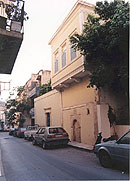
It
is one of the most stylish and interesting buildings of the Balkan architecture
in the city.
It was the house of the Turk Mirza Efendi and today it belongs to the
Italian School of Archaeology. The building is characterized by architectural
and morphological elements of Ottoman-Turkish and Neo-Classical architecture.
 It has been characterized
as a listed historical monument and work of art. It
has two floors and it is an excellent example of Neoclassical architecture.
On the south side of the building there is a courtyard that is enclosed
by a wall of Neoclassical style.
It has been characterized
as a listed historical monument and work of art. It
has two floors and it is an excellent example of Neoclassical architecture.
On the south side of the building there is a courtyard that is enclosed
by a wall of Neoclassical style.
It was built on the site of an earlier mansion in 1870 with plans of L.
Kantanzoglou. This then was burnt down and destroyed by the Turks during
the events of the 25th August 1898. It was rebuilt in 1903 with plans
of K. Tsantiraki that were based on the earlier ones.
 The
building «Efkafi» belongs to the family Miliara and it is one of the first
two public Turkish buildings that were built according to the principles
of Neoclassical architecture in Heraklion. It was erected around 1878
to roof the Service of Efkafia which was a Turkish Public Service that
had in its jurisdiction all the buildings that were offered to Philanthropic
establishments.
The
building «Efkafi» belongs to the family Miliara and it is one of the first
two public Turkish buildings that were built according to the principles
of Neoclassical architecture in Heraklion. It was erected around 1878
to roof the Service of Efkafia which was a Turkish Public Service that
had in its jurisdiction all the buildings that were offered to Philanthropic
establishments.
The building is exceptionally elegant and interesting, an example of the
first applications of Neoclassicism in Heraklion, to which a lot of elements
of the wide spread Balkan architecture were used.
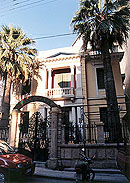
It is an important building of later Neoclassicism. It
has two floors with a basement and it is roofed with tiles. Its facade
is carefully formed, while the other sides are rather undorned.
Special attention was given to the formation of the middle part of the
main facade, where both on the ground and on the first floor there is
an architrave with Doric and Ionic columns accordingly, while its end
is crowned by a pediment.
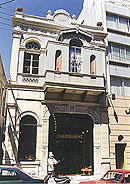 The well known «Bon Marche» is a private shop that belonged to the sons
Housein and Moharem Litsardaki.
The well known «Bon Marche» is a private shop that belonged to the sons
Housein and Moharem Litsardaki.
It was erected in 1892 in Ag. Minas 8 street and it is a significant example
of a Turkish building where elements from the Neoclassical and Balkan
architecture have been successfully fused.
Building of the family Kalioraki in Sofokli Venizelou Avenue and Theotokopoulou street.
 The
building is a fine example of the late Neoclassicism and typical of the
late Neoclassicism and typical of the city architecture of the first decades
of the 20th century.
The
building is a fine example of the late Neoclassicism and typical of the
late Neoclassicism and typical of the city architecture of the first decades
of the 20th century.

It
is a very interesting stone built building with two floors and tiled roof
of the late Neoclassicism and Eclectism.
On the ground flloor the openings are framed by ashlar masonry (stone
curved columns). The entrance to the first floor is found at the side
of the building.
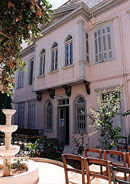 It
is a characteristic example of the balkan architecture with clear neoclassical
influence. The size, the structure of the rooms, the variety of the forms
of the other parts and the high aesthetic conception establish the building
unique in Heraklion.
It
is a characteristic example of the balkan architecture with clear neoclassical
influence. The size, the structure of the rooms, the variety of the forms
of the other parts and the high aesthetic conception establish the building
unique in Heraklion.
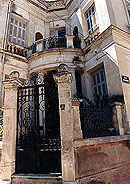
This
house is one of the most stylish examples of the late «romantique» Neoclassicism.
It was built in the first decade of the 20th. century by the architect
D.Kyriakos. Especially interesting is the architectural solution with
which the facades of the building have been formed which are laid out
in a semi-circular way in the corner where the roads meet.
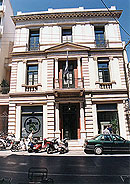 An excellent example
of the late Neoclassicism is the building known as «Mavraki House», property
of the «Credit Bank». It was probably erected in the second decade of
the 20th century in the neighbourhood Retzep Agha no. 167 street, which
a little later was called Sfakion street. The
first owner Zaharias Ieronymakis bequested it in 1921 to his son Heraklis
Ieronymakis who sold it to Emmanouil Pantelakis. He in turn gave it as
a dowry at his daughter to the lawyer S.Mavraki in 1948.
An excellent example
of the late Neoclassicism is the building known as «Mavraki House», property
of the «Credit Bank». It was probably erected in the second decade of
the 20th century in the neighbourhood Retzep Agha no. 167 street, which
a little later was called Sfakion street. The
first owner Zaharias Ieronymakis bequested it in 1921 to his son Heraklis
Ieronymakis who sold it to Emmanouil Pantelakis. He in turn gave it as
a dowry at his daughter to the lawyer S.Mavraki in 1948.
The building has all the characteristics of the later Neoclassicism. The
formation of the main facades is strictly symmetrical. The main architectural
element, which is unique for Heraklion, is the dome like wooden structure
of the building. Structures like these, called «Belvedere», were very
usual in north Europe. While they were often used in city centres of central
and north Greece (Athens, Thessaloniki, Patras) and in luxurious suburbs
as Kifissia, they were however rarely found in southern Greece and in
the islands.
* The Greek section
on the buildings of the 19th. and 20th. century was written by:
K.Koiladi, G.Kolyvakis, K.Lempidaki, N.Papadakis-Chourdakis and Ch. Tsompanaki.
The co-ordinator: Ch.Tsompanaki.
February 1994
Region of Crete, TEE-TAK
· The text was summarised and translated into English by Kalliopi Nikolidaki.
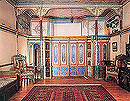 It
is a remarkable building of the Balkan architecture with Neoclassical
influences and a very interesting internal painted decoration. The arrangement
of the rooms is complex, they are around open spaces or semi-open internal
ones covered with pebbled floors. The ground floor is stone built as also
are parts of the first floor while the rest is wooden. The wood becomes
the main structural and morphological element of the whole construction.
Especially important are the wooden elements too (ceiling, wardrobes,
internal partitions) which are characteristic examples of the architecture
and the aesthetic conception of this group of buildings.
It
is a remarkable building of the Balkan architecture with Neoclassical
influences and a very interesting internal painted decoration. The arrangement
of the rooms is complex, they are around open spaces or semi-open internal
ones covered with pebbled floors. The ground floor is stone built as also
are parts of the first floor while the rest is wooden. The wood becomes
the main structural and morphological element of the whole construction.
Especially important are the wooden elements too (ceiling, wardrobes,
internal partitions) which are characteristic examples of the architecture
and the aesthetic conception of this group of buildings.
The building has been renovated by the Technical Service of the Town Hall
(in collaboration with the local Ephorate which is responsible for the
recent monuments) and it contains objects of art that appertain to its
character and, at the same time, it houses a series of things that have
a particular importance to the understanding of the whole cultural physiognomy
of the city of Heraklion.
Some of them are:
* the Greek text
was written by Mrs. Eirini Vallindra - Schizaki,
Architect of the Heraklion Municipality